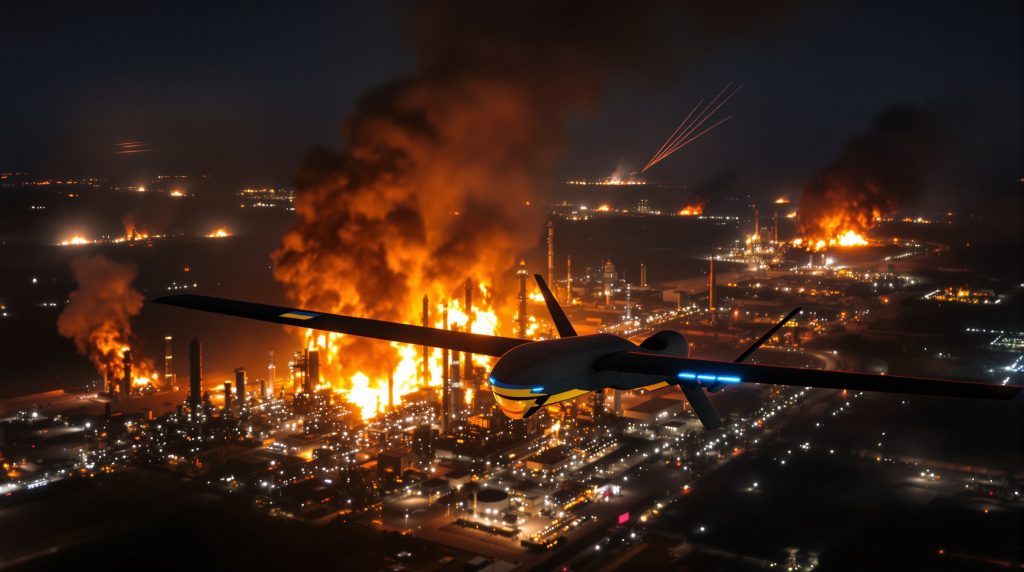How Ukrainian Drone Strikes Have Affected Russia's Oil Infrastructure
Ukrainian drone attacks have emerged as a significant asymmetric warfare tactic, targeting Russia's vital oil refining infrastructure with remarkable precision and strategic impact. These operations have systematically degraded Russia's domestic fuel production capacity, creating supply shortages and economic pressure across multiple regions.
The strikes represent a calculated effort to undermine Russia's energy security and economic stability by targeting facilities that are essential to both its domestic fuel supply and export capabilities. By disrupting these operations, Ukraine has managed to inflict economic damage while avoiding direct military confrontation with Russian forces.
According to Ukrainian President Volodymyr Zelenskyy, these attacks have created a fuel shortage ranging from 13-20% of Russian demand, with his assessment placing it at approximately 20%. This information was shared in a post on social media platform X in October 2025.
"Our weapons are delivering tangible results," Zelenskyy noted, adding that Russia has "begun tapping into diesel reserves, which they've been saving for a rainy day."
What Makes Russian Oil Refineries Strategic Targets?
Critical Infrastructure Vulnerabilities
Russian oil refineries present ideal strategic targets for several reasons:
-
They contain highly flammable materials that can sustain damage from relatively small explosive payloads
-
Many facilities feature extensive physical footprints that are difficult to defend completely
-
The refineries are large, stationary targets that are difficult to conceal or relocate
-
They represent a direct link between Russia's natural resources and its economic stability
Economic Significance
Oil refineries play a crucial role in Russia's economy:
| Economic Factor | Impact of Refinery Operations |
|---|---|
| Domestic fuel supply | Provides gasoline and diesel for civilian and military use |
| Export revenue | Refined petroleum products generate significant foreign currency |
| Employment | Supports thousands of jobs in regional economies |
| Industrial supply chain | Produces feedstocks for petrochemical industries |
Disrupting these facilities creates cascading effects throughout Russia's economy, from transportation difficulties to manufacturing constraints. Furthermore, oil price movements on global markets can be significantly influenced by such disruptions, creating additional economic pressure.
How Extensive Are Ukraine's Drone Strikes on Russian Refineries?
Geographic Scope and Targeting Pattern
Ukrainian drone attacks have demonstrated an impressive operational reach, striking facilities deep within Russian territory:
-
Attacks have targeted refineries at significant distances from Ukraine's border
-
Strikes have occurred across multiple Russian regions, from western areas near the border to facilities deeper in Russian territory
-
Operations have focused on production units, storage tanks, and distillation columns—components critical to refinery operations
Major Facilities Targeted
Ukrainian forces have conducted successful strikes against several significant Russian refineries:
-
Kirishi Refinery (Leningrad Region): A major facility with substantial annual production capacity
-
Antipinsky Refinery (Tyumen): A facility with significant processing capabilities
-
Orsknefteorgsintez Refinery (Orenburg): Major regional producer with considerable capacity
-
Multiple facilities in Rostov Region: Including important oil depots that serve as critical distribution points
At least 10 refineries have been confirmed as targets of Ukrainian drone attacks, according to reports from Oilprice.com in October 2025. These attacks have contributed to an ongoing oil and gas downturn that has impacted markets globally.
What Technological Capabilities Enable These Long-Range Strikes?
Drone Technology Advancements
Ukraine has developed and deployed increasingly sophisticated drone platforms:
-
Extended Range: Domestically produced drones with significant operational range capabilities
-
Payload Capacity: Current systems can deliver sufficient explosives to damage critical infrastructure
-
Navigation Systems: Advanced guidance allows precision strikes on specific refinery components
-
Stealth Capabilities: Low radar cross-section and flight profiles that avoid detection
Operational Adaptations
Ukrainian forces have demonstrated tactical innovation in their drone operations:
-
Launching multiple drones simultaneously to overwhelm air defenses
-
Timing attacks during weather conditions that hamper detection systems
-
Targeting specific vulnerable components within refineries rather than attempting to destroy entire facilities
-
Conducting repeated strikes against the same facilities to disrupt repair efforts
What Has Been the Impact on Russian Fuel Supplies?
Domestic Fuel Shortages
The cumulative effect of these strikes has created significant disruptions in Russia's fuel market:
-
Gasoline shortages estimated at 13-20% of domestic demand
-
Regional supply constraints affecting multiple areas
-
Increased pressure on existing fuel reserves
-
Use of strategic diesel reserves that were previously held for contingency purposes
Government Response Measures
Russian authorities have taken several steps to address the growing fuel crisis:
-
Extended ban on gasoline exports through the end of 2025
-
Introduced new restrictions on diesel exports by trading companies (non-producers)
-
Implemented measures to stabilize domestic supply
-
Accelerated repair efforts at damaged facilities
-
Increased security measures around remaining operational refineries
These export restrictions were confirmed by Russian officials, as reported by Oilprice.com in October 2025. The resulting stagnant oil prices have created additional economic challenges for Russia's budget.
How Has Russia's Refining Capacity Been Affected?
Production Disruptions
The strikes have had varying impacts on different facilities:
-
Some refineries have experienced complete shutdowns of specific processing units
-
Others have continued operations at reduced capacity
-
Several facilities have reported fires that required days or weeks to fully extinguish
-
Secondary damage from fires has affected infrastructure beyond the initial impact points
According to reports, some facilities have sustained damages and temporarily halted crude intake, though Russia has not officially commented on the extent of damage. As reported by The Kyiv Independent, one of the most significant attacks targeted a major oil refinery in Russia's Leningrad region.
Recovery Efforts and Challenges
Russia faces significant challenges in restoring full operational capacity:
-
Specialized equipment for refineries often requires complex components
-
Repair timelines are extended due to the complexity of refinery systems
-
Some facilities require complete rebuilding of damaged processing units
-
Security upgrades divert resources from production restoration
What Are the Strategic Implications of These Attacks?
Military Resource Allocation
The drone campaign has forced Russia to make difficult strategic choices:
-
Diversion of air defense systems to protect critical infrastructure
-
Increased security personnel requirements at numerous potential targets
-
Resource allocation to emergency response and repair operations
-
Logistics challenges for military operations due to fuel constraints
Economic Pressure Points
The economic impact extends beyond immediate fuel shortages:
-
Increased government spending on supply stabilization measures
-
Reduced export revenue from refined petroleum products
-
Higher transportation costs affecting consumer goods prices
-
Potential long-term investment requirements to rebuild and harden infrastructure
The OPEC production impact has also been significant, as the organization considers how to respond to these market disruptions.
How Has the Conflict Escalated Through Energy Infrastructure Targeting?
Reciprocal Infrastructure Attacks
Both sides have increasingly targeted energy infrastructure:
-
Russia has conducted extensive strikes on Ukraine's energy grid and natural gas production facilities
-
Ukrainian gas production has decreased by approximately 60% following Russian attacks
-
Critical power generation and distribution networks in both countries have been damaged
-
Civilian populations in both nations face increasing energy insecurity as winter approaches
The impact on Ukraine's energy infrastructure has been severe. On October 3, 2025, Russia conducted what Naftogaz Group described as the largest strike on their gas production facilities since the start of the war in 2022. These strikes occurred in the Poltava and Kharkiv regions, forcing the shutdown of about 60% of Ukrainian natural gas production, according to sources cited by Bloomberg in October 2025.
Humanitarian Concerns
The targeting of energy infrastructure raises significant humanitarian issues:
-
Potential civilian hardships during winter months due to energy shortages
-
Environmental impacts from refinery fires and damaged facilities
-
Long-term economic consequences for communities dependent on energy infrastructure
-
Increased costs for basic necessities as energy prices rise
According to Reuters, the systematic targeting of energy infrastructure by both sides has raised concerns about potential humanitarian consequences as winter approaches.
What Are the International Market Implications?
Global Oil Market Response
The attacks have created ripple effects in international energy markets:
-
Market volatility following major strikes on significant facilities
-
Increased uncertainty about Russia's export capabilities
-
Shifts in regional supply patterns as Russia redirects remaining export capacity
-
Growing risk assessments for energy infrastructure in conflict zones
Supply Chain Adjustments
International markets have begun adapting to the new reality:
-
European refiners adjusting to changes in Russian diesel export availability
-
Asian buyers potentially facing altered supply patterns from Russian sources
-
Modified shipping routes as alternative supply chains develop
-
Risk evaluation changes for operations in affected regions
The trend of easing oil prices seen earlier in the year has been disrupted by these attacks, creating new market dynamics.
What Does This Mean for the Future of the Conflict?
Escalation Potential
The targeting of energy infrastructure represents a significant escalation with several potential implications:
-
Increased likelihood of similar tactics being employed by both sides
-
Possible expansion of target sets to include other types of critical infrastructure
-
Growing economic costs that may influence strategic calculations
-
Potential for unintended consequences from infrastructure attacks
Long-term Considerations
The conflict's energy dimension creates lasting strategic challenges:
-
Post-conflict reconstruction requirements will be substantially increased
-
Energy security will remain a critical vulnerability for both nations
-
Infrastructure protection and redundancy will require significant investment
-
Regional energy flows may be permanently altered by the conflict
Conclusion
Ukrainian drone attacks on Russian refineries have evolved into a strategically significant aspect of the ongoing conflict. By targeting critical energy infrastructure deep within Russian territory, Ukraine has managed to create substantial economic pressure while demonstrating advanced technological capabilities.
The estimated 20% reduction in Russian gasoline supply represents a tangible achievement in Ukraine's asymmetric approach to the conflict. Meanwhile, Russia's extension of fuel export bans indicates the seriousness with which authorities view the situation.
As both sides continue to target each other's energy infrastructure, the humanitarian and economic costs continue to mount. The approaching winter months will likely intensify the significance of these attacks, potentially influencing broader strategic calculations in the conflict.
Disclaimer: This analysis is based on reported information as of October 2025 and represents the known state of the conflict at that time. The ongoing situation remains fluid, with both tactical developments and strategic implications continuing to evolve.
Want to Stay Ahead of Major Mineral Discoveries?
Discover significant ASX mineral announcements before the market does with Discovery Alert's proprietary Discovery IQ model, providing real-time notifications of high-potential discoveries. Visit our discoveries page to see how historic mineral finds have generated substantial returns and start your 30-day free trial today.




